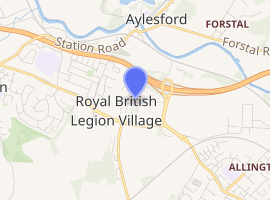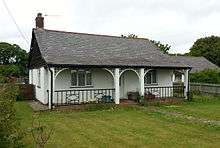Preston Hall, Aylesford
Preston Hall is a former manorial home and associated estate in Aylesford in the English county of Kent. It dates to the Norman period and was owned by the Culpepper family for over 400 years. Part of the estate became the Royal British Legion Village in the 1920s and the hall itself was used as a hospital after World War II. The estate was broken up over a period of time and most of the area it once covered is now used for housing. The hall itself was transformed into 36 flats in 2015. The Heart of Kent Hospice also occupies a site on the property.
| Preston Hall, Aylesford | |
|---|---|
 Front view of Preston Hall | |

| |
| General information | |
| Architectural style | Jacobean style |
| Completed | 1850 |
| Design and construction | |
| Architect | John Thomas |
At the end of the 19th century the estate stretched from the current A20 to the River Medway just south of Aylesford.[1][2] The hall is located towards the southern edge of the estate, having been rebuilt there in the mid 19th century. It is around 2.5 miles (4.0 km) north-west of Maidstone and 0.5 miles (0.80 km) south of Aylesford. The M20 motorway and the Maidstone to Strood railway line both cross the former estate between the hall and the river. Junction 5 of the M20 and Aylesford railway station are on the edges of the former estate.[1][3]
History
The estate dates to at least 1102. Between around 1300 and 1734 the estate was owned by the Culpeper baronets. Jeffrey Culpepper was High Sheriff of Kent twice, once between 1364–66 and again in 1374 and the family remained influential in Kent throughout their time at the hall. The Baronetcy of Culpeper of Preston Hall was created on 17 May 1627 for William Culpeper. He served as High Sheriff of Kent in 1637 and his grandson, Sir Thomas Culpeper, 3rd Baronet served as High Sheriff in 1704 and was Member of Parliament for Maidstone between 1705 and 1713 and again between 1715 and 1723. On his death in 1723 the estates passed to Alicia Culpepper, Thomas' sister, and, though her, to her husband's family, the Milners.[4][5][6]
The Milner family lived at Preston Hall until the mid 19th century, Charles Milner also serving as High Sheriff in 1808.[7] The property was purchased by Edward Ladd Betts, a successful railway contractor, in 1848.[5] When the estate was offered for sale it covered an area of 180 acres (73 ha), although much more land was in the ownership of the estate in parishes stretching from Boxley and Burham to East Malling, with farmland covering 1,650 acres (670 ha) and woodlands extending for 800 acres (320 ha).[2] Betts demolished the old house and commissioned John Thomas to build a replacement in the Jacobean style slightly to the south of the original house location.[1][8][9] Thomas had worked for Betts' brother-in-law and business partner, Samuel Morton Peto, at Somerleyton Hall in Suffolk.[5]
Betts landscaped the estate during his time at the hall, laying out a series of carriage drivers and lawns. He built Aylesford railway station on the Medway Valley Line to make his access to Preston Hall easier.[5] Betts ran into financial difficulties after the banking crisis of 1866, became insolvent the following year and was forced to sell the hall which was brought by Thomas Brassey, also a railway contractor.[5]
Brassey had worked with Betts and Peto in the Peto, Brassey and Betts partnership. The hall was inherited by his son, Henry Brassey who was MP for Sandwich, in 1870. On the death of Brassey's wife in 1898 the hall was inherited by their son, Henry Leonard Campbell Brassey and his wife Violet. The couple moved to Apethorpe Hall in Northamptonshire in 1904 and sold off much of the land associated with the estate which was reduced to around 24.9 acres (10.1 ha) in area.[5]
Royal British Legion Village


During World War I the hall was used as a hospital and convalescent home for servicemen wounded in the war. It built a particular reputation for the treatment of tuberculosis (TB).[9][10][11][12] After the war the site was purchased to establish a sanatorium, training colony and village for wounded servicemen and to act as a centre for the treatment of TB. The estate became known as the Preston Hall Colony.[9][13]
At a time when the only treatment for TB was fresh air and rest, the cottages had verandas so that TB patient’s beds could be pushed outside. The cottages were large enough that patient’s families could live with them. Eventually about 30 cottages were built. Numbers of patients had fallen by 1925 when the Royal British Legion Industries took over the running of the colony.[14][15] The village quickly increased in population and became known as the British Legion Village.[16] The Medical Director of the sanatorium between 1924 and 1944 was Dr John McDougall who later went on to be Chief Tuberculosis Officer of the World Health Organization from 1945.[17]
Royal British Legion Industries (RBLI) maintains its presence at the village. Gavin Astor House provides specialist nursing care and there are assisted living areas for elderly forces veterans. Over 100 housing units are provided for veterans and their families and temporary accommodation is also provided on the site which provides housing for over 300 people.[18] Employment opportunities are also provided on the site and in 1972 the Poppy Appeal headquarters moved to the village.[19] An industrial complex in the village houses Britain's Bravest Manufacturing Company, run by the Royal British Legion Industries (RBLI), including the manufacturing of road and public signs used throughout the UK.[20]
Hospital
This hall was again used as a hospital during World War II and was brought into the National Health Service when it was established in 1948.[9] It was used first as a specialist chest hospital before becoming a general hospital. When the Maidstone General Hospital opened in the early 1980s the hall was used as the headquarters of the Maidstone Health Authority until 2012.[11][21]
Modern use
In March 2014 the hall was sold by the Department of Health to Weston Homes for a nominal fee to be converted into residential apartments. Some areas were in poor condition and repairs were made later in the year before a total of 36 flats were developed in the original building in 2015.[21][22][23] Other areas of the site have been developed as further areas of housing.[24][25]
Part of the estate is the site of the Heart of Kent Hospice, opened in 1992.[11]
Cricket ground
| Ground information | |||||
|---|---|---|---|---|---|
| Location | Aylesford, Kent | ||||
| Coordinates | 51.295°N 0.477°E (approx.) | ||||
| Establishment | 1846 (first recorded match) | ||||
| Operator | Preston Hall | ||||
| Team information | |||||
| |||||
| As of 4 December 2017 Source: CricketArchive | |||||
A cricket ground had been built within the grounds of the hall by the mid 19th century. It was used in 1846 and 1847, when the hall was owned by the Milner family, by Kent County Cricket Club for two first-class cricket matches, both played against Surrey. These were the ground's only first-class fixtures[26] and were held as part of an attempt to form a rival to the Canterbury based Kent club.[27]
Prior to the formation of the first county club in 1842, Kent teams had played at the Old County Ground in Town Malling, 2.5 miles (4.0 km) west of Preston Hall. The county returned to the ground to play four matches later in the 19th century. They also played over 250 matches at Mote Park in Maidstone between 1859 and 2005.[28] Kent's Second XI played a number of matches at Cobdown Sports Ground in Ditton, around 1 mile (1.6 km) to the west of Preston Hall, between 1948 and 1977.[29]
The ground was also used for a number of non-first-class matches. Aylesford Cricket Club used the ground during the ownership of Charles Milner[27] and a side called Preston Hall used the ground between 1873 and 1897, as did a team bearing the name of Henry Brassey. Matches are known to have been played against a variety of well-known amateur teams including I Zingari, Free Foresters, The Mote, Royal Engineers, Sevenoaks Vine and Eton Ramblers.[30] Areas of sports fields remain in use as playing fields on land which was once owned by the estate between the M20 motorway and the River Medway,[3] but the cricket ground is no longer in existence.[28]
References
- Ordnance Survey Map of Kent, XXXI.SW. Revised: 1895, Published: 1898.
- The Preston Hall Estate, near Maidstone, Kent, The Times, issue 19758, 1848-01-13, p.10.
- Explorer Map 148 – Maidstone & the Medway Towns, Ordnance Survey, 2015-09-16.
- Burke J, Burke JB (1838) Culpepper of Preston Hall, A genealogical and heraldic history of the extinct and dormant baronetcies of England, pp.143–144. London: John Russell Smith. (Available online. Retrieved 2017-12-02).
- Preston Hall History, Weston Homes Plc, 2015-01-25. Retrieved 2017-12-03.
- Handley S (2002) COLEPEPER (CULPEPER), Sir Thomas, 3rd Bt. (c.1656-1723), of Preston Hall, nr. Maidstone, Kent, The History of Parliament. Retrieved 2017-12-05.
- "No. 16115". The London Gazette. 1808-02-02. p. 173.
- Preston Hall, Historic England. Retrieved 2017-12-03.
- History, Aylesford Parish Council. Retrieved 2017-12-03.
- Preston Hall History – 1900 - Present Day, Weston Homes Plc, 2015-01-28. Retrieved 2017-12-05.
- Royal British Legion Village, Welcome to Maidstone. Retrieved 2017-12-05.
- Tributes paid to devoted chest doctor, Kent Online, 2002-04-26. Retrieved 2017-12-06.
- Tubercular Ex-Service Men, The Times, issue 42360, 1920-03-16, p.13.
- Future Of Preston Hall, The Times, issue 43652, 1924-05-15, p.12.
- British Legion Village, The Times, issue 45723, 1931-01-17, p.8.
- Our history, Royal British Legion Industries. Retrieved 2017-12-05.
- Former Fellows of The Royal Society of Edinburgh 1783 – 2002 Archived 2016-03-04 at the Wayback Machine, The Royal Society of Edinburgh, July 2006. Retrieved 2017-12-05.
- Housing and care, Royal British Legion Industries. Retrieved 2017-12-05.
- Graham M (2012) Video: Millions of poppies start life at Royal British Legion Village in Aylesford, Kent Online, 2012-11-09. Retrieved 2017-12-05.
- Stephen P (2016) Made by Britain's bravest, Rail Magazine, 2016-07-06, issue 804, p.60.
- McWethy C (2014) Experts say parts of Preston Hall, in the heart of Aylesford’s Royal British Legion Village, are at risk of crumbling and pose a risk to the public, Kent Online, 2014-11-10. Retrieved 2017-12-06.
- Property of the day: Preston Hall, Aylesford, Town & Country, 2015-11-30. Retrieved 2017-12-03.
- Yours for £195,000: how you can own part of a Wolf Hall-style Tudor mansion, The Daily Telegraph, 2015-02-11. Retrieved 2017-12-06.
- The Lawns, Preston Hall Park, Redrow Homes. Retrieved 2017-12-06.
- McConnell E (2017) Hermitage Lane: 3,712 homes to be built along key route between Maidstone and Aylesford in next 20 years, Kent Online, 2017-07-18. Retrieved 2017-12-06.
- First-Class Matches played on Preston Hall Ground, Aylesford, CricketArchive. Retrieved 2017-12-06.
- Milton H (1979) Kent cricket grounds, in The Cricket Statistician, no. 28, December 1979, pp.2–10.
- Grounds Records in Kent County Cricket Club Annual 2017, pp.210–211. Canterbury: Kent County Cricket Club.
- Cobdown Sports Ground, Aylesford, CricketArchive. Retrieved 2017-12-07.
- Other matches played on Preston Hall Ground, Aylesford, CricketArchive. Retrieved 2017-12-06.
External links
- The Heart of Kent Hospice
- Preston Hall on the British Towns and Villages Network